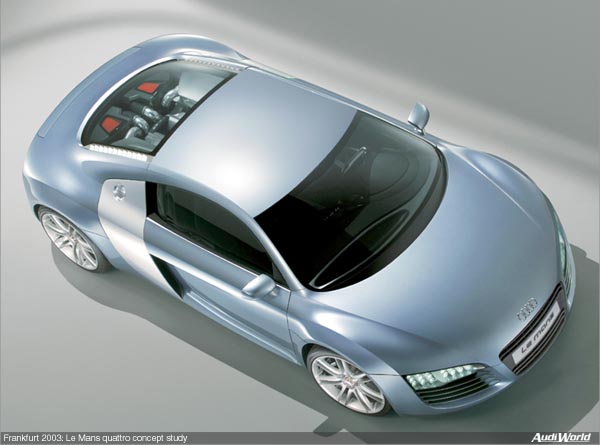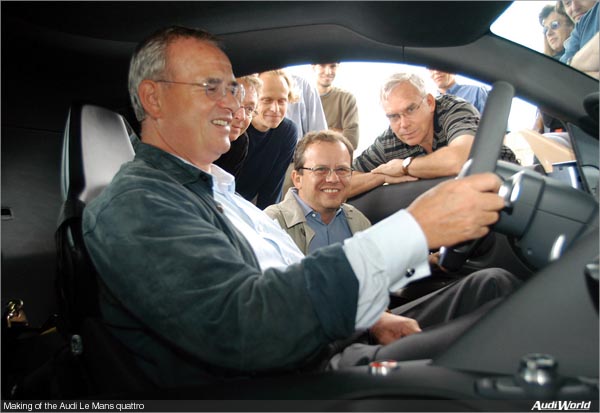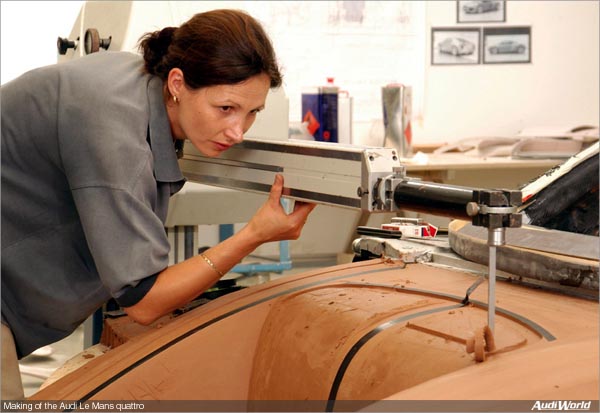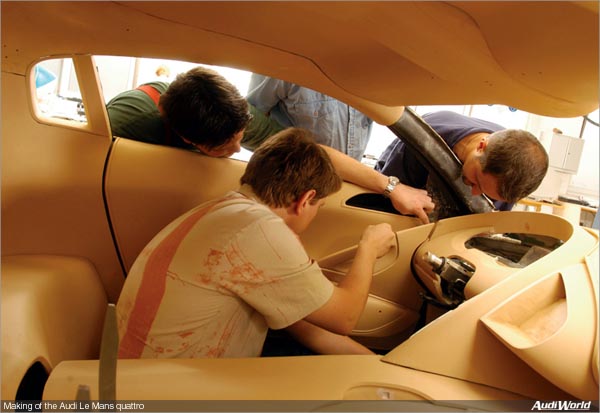Craftsmanship and High-Tech: The Making of the Audi Le Mans quattro

The Audi Le Mans quattro is the first car of its kind: a high-performance sports car that sends a tingle down your spine but is also suitable for regular day-to-day driving – a driving machine with luxury built in. It was developed in conditions of strict secrecy, according to the Audi philosophy that even a show car must be close to reality and fully functional. Only eleven months elapsed between the first design sketches and the car’s sensational debut at the 2003 Frankfurt Motor Show. The car’s concept indicates the direction that future Audi developments will take, with its combination of stimulating design and the brand’s entire motor-sport and technical know-how. But how does a show car like the Le Mans quattro come into being? Let us look at the making of this car in more detail. Our first source of information is Dirk Isgen, Head of Concept Development at AUDI AG. He tells us: “Following the Pikes Peak quattro and the Nuvolari quattro, this is the third Audi concept car to appear this year. It is evidence of our future formal idiom and the brand’s model policy. It is a thoroughbred mid-engined sports car concept that for the first time makes the technical features of the successful Audi R8 competition car available for road driving. You can imagine that we are doubly pleased when the innovative high-tech features on a car such as this prove to function well and the car can be driven.” The Le Mans quattro certainly has a vast number of new technical features, for example its innovative LED lighting, its aluminium frame structure with carbon-fibre reinforced outer skin made of plastic and composite material, its digital cockpit display, the 5.0-litre twin-turbo V10 engine with petrol direct injection FSI and the new Audi magnetic ride suspension concept – all visionary technologies that are far more than a glimpse of some distant future, since they can now be sampled in practice in the Le Mans quattro.
It took the team a mere eleven months to design and construct this car with its top-quality cutting-edge technology. This tight time schedule was a dream and a nightmare at one and the same time for the small development team assembled by overall project manager Bernhard Voll (Technical) and project managers Rüdiger Kiehn (Design), Frank Lamberty (Exterior Design) and Jens Sieber (Interior Design). Lamberty comments: “Assuming responsibility for a complete car is a very attractive prospect, but with a time schedule like this, the pressure and stress are much more severe. You have to enjoy what you’re doing!” Bernhard Voll reminds us, however, that only a small, efficient team would be able to meet such a tight deadline: “We were able to take decisions quickly and directly, since we all worked in one large room, every member of the team was normally available all the time and there were no multiple hierarchy levels to take into account.” His design colleague Lamberty agrees: “The need to reach quick decisions was much greater because of this enormous pressure of time, and so we were able to achieve tangible results far more quickly.” The race was on when, in October 2002, the Audi Board of Management decided to have the Le Mans quattro built. One team was just finishing the Pikes Peak concept study for the Detroit Motor Show, another was working hard on the Nuvolari GT show car for Geneva. The Board’s instructions to Concept Development and Design were nonetheless clear: “Develop a mid-engined supersports model.” The project was given the internal development code ‘F03’, standing for ‘Frankfurt 2003’ – in other words, the concept car for the IAA Frankfurt Motor Show. The two previous projects had been coded similarly: U03 (for USA) and G03 (for Geneva). In the words of Technical Project Manager Voll: “It was clear from the start that what was wanted was a high-performance sports car suitable for day-to-day use.” An ultimate driving machine, certainly, but one demanding no sacrifices in comfort and user-friendliness. A car just as capable of driving down to the hairdresser’s and parking there for an hour or two. As you can imagine, this was quite a challenge for us.”
An image board was used to compile a ‘personality’ for the Le Mans quattro. Attributes such as competition capability, luxury, high-tech, design and day-to-day suitability were shown on the board as associative photo motifs, together with the intended target group, the driver’s lifestyle and the car’s historical relevance (for instance its affinity with Auto Union racing cars). Following discussions on strategy with Dr. Martin Winterkorn, Audi’s Chairman and Board Member for Technical Development, the first presentation was held before the end of October 2002, with drawings and sketches shown to the Board, after which the basic concept of the car – its ‘package’ was finalised. After this, a creative competition was organised between Audi Design’s stylists at company headquarters in Ingolstadt and those at the Audi Design Centre in Munich. Lamberty has this to say: “Such competitions are very hard on everyone involved. Five teams submitted drafts, but of course only one could be chosen. But members of those that lost out were invited to join the final development team.”
Pages: [1] [2] |



